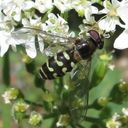Syrphini
Syrphini
Classification
Pronunciation
How to pronounce Syrphini: //sɪrˈfaɪ.naɪ//
These audio files are automatically generated. While they are not always 100% accurate, they are a good starting point.
Images






Summary
Syrphini is the most speciose tribe of hoverflies, consisting of more than 140 species across about 30 genera in specific regions, renowned for their wasp-like appearance and ecological role as predators of aphids during their larval stage.
Physical Characteristics
Moderate size hoverflies, typically with wasp-like markings.
Identification Tips
Identify using wing patterns and body coloration which often resemble wasps to deter predators.
Habitat
Found in a variety of habitats, including gardens, meadows, and near water sources where flowering plants are present.
Distribution
Widely distributed, with >140 species identified in some regions.
Diet
Larvae are predatory, primarily feeding on aphids.
Life Cycle
Includes four main stages: egg, larva (with early and late stages), puparium, and adult.
Reproduction
Reproduction involves laying eggs, which hatch into predatory larvae.
Ecosystem Role
As adults, they are important pollinators, while larvae help control aphid populations.
Collecting Methods
- Netting adults during flight
- Collecting larvae from aphid-infested plants
Preservation Methods
- Pinning adults
- Preserving larvae in alcohol
Evolution
Taxonomy in flux; genetic relationships suggest members fall into several smaller clades.
Misconceptions
Often mistaken for bees due to their coloration and body shape, but they are harmless hoverflies.
Tags
- Hoverflies
- Pollinators
- Syrphini
- Aphid predators